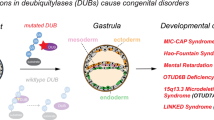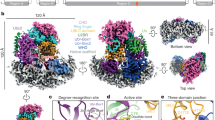Abstract
Ubiquitin-like proteins (UBLs) modify targets via related E1-E2-E3 cascades. How is UBL conjugation fidelity established? Here we report the basis for UBL selection by UBL conjugating enzyme 12 (Ubc12), which is specific for the neural precursor cell expressed, developmentally down-regulated protein 8 (NEDD8), and does not form a thioester-linked conjugate with ubiquitin. We systematically identified Ubc12 surfaces impeding Ubc12∼ubiquitin conjugate formation and found that several structurally dispersed E1 binding elements, rather than UBL-interacting surfaces, determine E2∼UBL specificity. In addition to roles for conserved E1 and E2 domains, unique structures contribute UBL specificity to the NEDD8 and ubiquitin pathways. By removing surface elements, without substituting corresponding sequences from ubiquitin E2s, we unmasked Ubc12's vestigial preference for ubiquitin over NEDD8 by ∼1010-fold. This has implications for the evolution of specific functions among ubiquitin E2s. We also find that Ubc12 sequences dictating UBL selection map to the E3 binding site, thus providing a molecular mechanism preventing inappropriate modification of targets.
This is a preview of subscription content, access via your institution
Access options
Subscribe to this journal
Receive 12 print issues and online access
$189.00 per year
only $15.75 per issue
Buy this article
- Purchase on Springer Link
- Instant access to full article PDF
Prices may be subject to local taxes which are calculated during checkout






Similar content being viewed by others
References
Pickart, C.M. & Fushman, D. Polyubiquitin chains: polymeric protein signals. Curr. Opin. Chem. Biol. 8, 610–616 (2004).
Hicke, L., Schubert, H.L. & Hill, C.P. Ubiquitin-binding domains. Nat. Rev. Mol. Cell Biol. 6, 610–621 (2005).
Hurley, J.H., Lee, S. & Prag, G. Ubiquitin-binding domains. Biochem. J. 399, 361–372 (2006).
Harper, J.W. & Schulman, B.A. Structural complexity in ubiquitin recognition. Cell 124, 1133–1136 (2006).
Kerscher, O., Felberbaum, R. & Hochstrasser, M. Modification of proteins by ubiquitin and ubiquitin-like proteins. Annu. Rev. Cell Dev. Biol. 22, 159–180 (2006).
Dye, B.T. & Schulman, B.A. Structural mechanisms underlying posttranslational modification by ubiquitin-like proteins. Annu. Rev. Biophys. Biomol. Struct. 36, 131–150 (2007).
Schwartz, D.C. & Hochstrasser, M. A superfamily of protein tags: ubiquitin, SUMO and related modifiers. Trends Biochem. Sci. 28, 321–328 (2003).
Pan, Z.Q., Kentsis, A., Dias, D.C., Yamoah, K. & Wu, K. Nedd8 on cullin: building an expressway to protein destruction. Oncogene 23, 1985–1997 (2004).
Osaka, F. et al. Covalent modifier NEDD8 is essential for SCF ubiquitin-ligase in fission yeast. EMBO J. 19, 3475–3484 (2000).
Tateishi, K., Omata, M., Tanaka, K. & Chiba, T. The NEDD8 system is essential for cell cycle progression and morphogenetic pathway in mice. J. Cell Biol. 155, 571–579 (2001).
Pickart, C.M. & Eddins, M.J. Ubiquitin: structures, functions, mechanisms. Biochim. Biophys. Acta 1695, 55–72 (2004).
Bohnsack, R.N. & Haas, A.L. Conservation in the mechanism of Nedd8 activation by the human AppBp1-Uba3 heterodimer. J. Biol. Chem. 278, 26823–26830 (2003).
Huang, D.T. et al. Structural basis for recruitment of Ubc12 by an E2 binding domain in NEDD8's E1. Mol. Cell 17, 341–350 (2005).
Eletr, Z.M., Huang, D.T., Duda, D.M., Schulman, B.A. & Kuhlman, B. E2 conjugating enzymes must disengage from their E1 enzymes before E3-dependent ubiquitin and ubiquitin-like transfer. Nat. Struct. Mol. Biol. 12, 933–934 (2005).
Burroughs, A.M., Balaji, S., Iyer, L.M. & Aravind, L. Small but versatile: the extraordinary functional and structural diversity of the β-grasp fold. Biol. Direct 2, 18 (2007).
Jin, J., Li, X., Gygi, S.P. & Harper, J.W. Dual E1 activation systems for ubiquitin differentially regulate E2 enzyme charging. Nature 447, 1135–1138 (2007).
Pelzer, C. et al. UBE1L2, a novel E1 enzyme specific for ubiquitin. J. Biol. Chem. 282, 23010–23014 (2007).
Chiu, Y.H., Sun, Q. & Chen, Z.J. E1–L2 activates both ubiquitin and FAT10. Mol. Cell 27, 1014–1023 (2007).
Liakopoulos, D., Doenges, G., Matuschewski, K. & Jentsch, S. A novel protein modification pathway related to the ubiquitin system. EMBO J. 17, 2208–2214 (1998).
Osaka, F. et al. A new NEDD8-ligating system for cullin-4A. Genes Dev. 12, 2263–2268 (1998).
Gong, L. & Yeh, E.T. Identification of the activating and conjugating enzymes of the NEDD8 conjugation pathway. J. Biol. Chem. 274, 12036–12042 (1999).
Millenium Pharmaceuticals, Inc. Inhibitors of E1 activating enzymes. United States Patent and Trademark Office no. 20070191293 (2007).
Kumar, A. et al. Commensal bacteria modulate cullin-dependent signaling via generation of reactive oxygen species. EMBO J. 26, 4457–4466 (2007).
Huang, D.T. et al. Basis for a ubiquitin-like protein thioester switch toggling E1–E2 affinity. Nature 445, 394–398 (2007).
Huang, D.T. et al. A unique E1–E2 interaction required for optimal conjugation of the ubiquitin-like protein NEDD8. Nat. Struct. Mol. Biol. 11, 927–935 (2004).
Havranek, J.J. & Harbury, P.B. Automated design of specificity in molecular recognition. Nat. Struct. Biol. 10, 45–52 (2003).
Bolon, D.N., Grant, R.A., Baker, T.A. & Sauer, R.T. Specificity versus stability in computational protein design. Proc. Natl. Acad. Sci. USA 102, 12724–12729 (2005).
Cunningham, B.C. & Wells, J.A. High-resolution epitope mapping of hGH-receptor interactions by alanine-scanning mutagenesis. Science 244, 1081–1085 (1989).
Rape, M. & Kirschner, M.W. Autonomous regulation of the anaphase-promoting complex couples mitosis to S-phase entry. Nature 432, 588–595 (2004).
Zheng, N., Wang, P., Jeffrey, P.D. & Pavletich, N.P. Structure of a c-Cbl-UbcH7 complex: RING domain function in ubiquitin-protein ligases. Cell 102, 533–539 (2000).
Zhang, M. et al. Chaperoned ubiquitylation—crystal structures of the CHIP U box E3 ubiquitin ligase and a CHIP-Ubc13-Uev1a complex. Mol. Cell 20, 525–538 (2005).
Christensen, D.E., Brzovic, P.S. & Klevit, R.E. E2-BRCA1 RING interactions dictate synthesis of mono- or specific polyubiquitin chain linkages. Nat. Struct. Mol. Biol. 14, 941–948 (2007).
Walden, H., Podgorski, M.S. & Schulman, B.A. Insights into the ubiquitin transfer cascade from the structure of the activating enzyme for NEDD8. Nature 422, 330–334 (2003).
Lois, L.M. & Lima, C.D. Structures of the SUMO E1 provide mechanistic insights into SUMO activation and E2 recruitment to E1. EMBO J. 24, 439–451 (2005).
Szczepanowski, R.H., Filipek, R. & Bochtler, M. Crystal structure of a fragment of mouse ubiquitin-activating enzyme. J. Biol. Chem. 280, 22006–22011 (2005).
Wang, J. et al. The intrinsic affinity between E2 and the Cys domain of E1 in ubiquitin-like modifications. Mol. Cell 27, 228–237 (2007).
Hatakeyama, S., Jensen, J.P. & Weissman, A.M. Subcellular localization and ubiquitin-conjugating enzyme (E2) interactions of mammalian HECT family ubiquitin protein ligases. J. Biol. Chem. 272, 15085–15092 (1997).
Anan, T. et al. Human ubiquitin-protein ligase Nedd4: expression, subcellular localization and selective interaction with ubiquitin-conjugating enzymes. Genes Cells 3, 751–763 (1998).
Reverter, D. & Lima, C.D. Insights into E3 ligase activity revealed by a SUMO-RanGAP1-Ubc9-Nup358 complex. Nature 435, 687–692 (2005).
Seol, J.H. et al. Cdc53/cullin and the essential Hrt1 RING-H2 subunit of SCF define a ubiquitin ligase module that activates the E2 enzyme Cdc34. Genes Dev. 13, 1614–1626 (1999).
Kamura, T. et al. Rbx1, a component of the VHL tumor suppressor complex and SCF ubiquitin ligase. Science 284, 657–661 (1999).
Ohta, T., Michel, J.J., Schottelius, A.J. & Xiong, Y. ROC1, a homolog of APC11, represents a family of cullin partners with an associated ubiquitin ligase activity. Mol. Cell 3, 535–541 (1999).
Morimoto, M., Nishida, T., Nagayama, Y. & Yasuda, H. Nedd8-modification of Cul1 is promoted by Roc1 as a Nedd8–E3 ligase and regulates its stability. Biochem. Biophys. Res. Commun. 301, 392–398 (2003).
Xirodimas, D.P., Saville, M.K., Bourdon, J.C., Hay, R.T. & Lane, D.P. Mdm2-mediated NEDD8 conjugation of p53 inhibits its transcriptional activity. Cell 118, 83–97 (2004).
Rodrigo-Brenni, M.C. & Morgan, D.O. Sequential E2s drive polyubiquitin chain assembly on APC targets. Cell 130, 127–139 (2007).
Kirkpatrick, D.S. et al. Quantitative analysis of in vitro ubiquitinated cyclin B1 reveals complex chain topology. Nat. Cell Biol. 8, 700–710 (2006).
Madura, K., Dohmen, R.J. & Varshavsky, A. N-recognin/Ubc2 interactions in the N-end rule pathway. J. Biol. Chem. 268, 12046–12054 (1993).
Zarrinpar, A., Park, S.H. & Lim, W.A. Optimization of specificity in a cellular protein interaction network by negative selection. Nature 426, 676–680 (2003).
Jones, R.B., Gordus, A., Krall, J.A. & MacBeath, G. A quantitative protein interaction network for the ErbB receptors using protein microarrays. Nature 439, 168–174 (2006).
Zheng, N. et al. Structure of the Cul1-Rbx1-Skp1-F boxSkp2 SCF ubiquitin ligase complex. Nature 416, 703–709 (2002).
Ciechanover, A., Elias, S., Heller, H. & Hershko, A. “Covalent affinity” purification of ubiquitin-activating enzyme. J. Biol. Chem. 257, 2537–2542 (1982).
Acknowledgements
We thank A. Varshavsky (Caltech) for the construct for expressing Ubc2p, D. Duda, B. Dye, H. Kamadurai and D. Scott for helpful discussions and critical reading of the manuscript, D. Miller for laboratory support and S. Bozeman for administrative support. This work was supported in part by ALSAC (American Syrian Lebanese Associated Charities), a Beckman Young Investigator Award, a Pew Scholar Award and grants from the US National Institutes of Health (R01GM069530 and R01GM077053) to B.A.S. B.A.S. is an Investigator of the Howard Hughes Medical Institute.
Author information
Authors and Affiliations
Contributions
D.T.H. and B.A.S. designed and supervised the experiments. D.T.H., M.Z., and O.A. performed the experiments. D.T.H. and B.A.S. wrote the paper.
Corresponding author
Supplementary information
Supplementary Text and Figures
Supplementary Figures 1–5 and Supplementary Methods (PDF 4103 kb)
Rights and permissions
About this article
Cite this article
Huang, D., Zhuang, M., Ayrault, O. et al. Identification of conjugation specificity determinants unmasks vestigial preference for ubiquitin within the NEDD8 E2. Nat Struct Mol Biol 15, 280–287 (2008). https://doi.org/10.1038/nsmb.1387
Received:
Accepted:
Published:
Issue Date:
DOI: https://doi.org/10.1038/nsmb.1387
This article is cited by
-
DCAF1-based PROTACs with activity against clinically validated targets overcoming intrinsic- and acquired-degrader resistance
Nature Communications (2024)
-
Targeting NEDD8-activating enzyme for cancer therapy: developments, clinical trials, challenges and future research directions
Journal of Hematology & Oncology (2023)
-
Ubiquitin-like protein activation by E1 enzymes: the apex for downstream signalling pathways
Nature Reviews Molecular Cell Biology (2009)
-
Building ubiquitin chains: E2 enzymes at work
Nature Reviews Molecular Cell Biology (2009)
-
K63-specific deubiquitination by two JAMM/MPN+ complexes: BRISC-associated Brcc36 and proteasomal Poh1
The EMBO Journal (2009)



